On Sunday night, in front of 1,000 fans at Allianz Stadium in Turin, the Italian champions of the last nine years, Juventus, hosted Claudio Ranieri’s Sampdoria in the first matchday of the 2020/21 Serie A season.
This tactical analysis breaks down the tactics of the match between Juventus and Sampdoria. With the use of match footage and data, this analysis unpacks what happened at Allianz Stadium in Juventus’s 3-0 win over Sampdoria.
Lineups
A lot of new trends and faces for Juventus, beginning with the manager. After the firing of Maurizio Sarri in the summer, Andrea Pirlo was appointed as the boss of the bianconeri. Pirlo already brought a change in Juventus’s formation, turning it into a 3-5-2, which often assumed the shape of a 3-4-2-1 or 3-4-1-2 during this game.
In goal, Wojciech Szczęsny was confirmed. With Mathias de Ligt back out due to injury, Leonardo Bonucci, Giorgio Chiellini and Danilo were the three men in the back. The injury of Alex Sandro had Pirlo opt for Gianluca Frabotta on the left flank, while Juan Cuadrado lined up on the right side. Rodrigo Bentancur, who recorded the highest tally for assists in Juventus last season with seven, started on the bench alongside new signing from Barcelona, Arthur Melo. The two central midfielders were Adrien Rabiot and 22-year-old American Weston McKennie, on loan from Bundesliga side Schalke. Aaron Ramsey sat just in front of them with the freedom to roam. On top, Pirlo could count on neither the winner of the 2019/20 Serie A Best Player, Paulo Dybala, nor Federico Bernardeschi, both out with injuries. The winner of last season’s Best Young Player, Dejan Kulusevski, featured next to Cristiano Ronaldo. The two of them had 41 goals and 14 assists combined in the past campaign.
The guests initially opted for a different line-up than their usual 4-4-2, the formation that allowed them to collect several points during the final stretch of the last Serie A season. At Juventus Stadium, Ranieri employed a more cautious 4-5-1, with few changes from last season’s personnel. In front of goalkeeper Emil Audero, the backline of four were, from right to left, Bartosz Bereszyński, Omar Colley, Lorenzo Tonelli and Tommaso Augello.
Fabio Depaoli played on the right-wing while the left flank featured Mehdi Léris. Sitting in the number six position was Albin Ekdal, with Jakub Jankto and Morten Thorsby next to him. Unable to count on Manolo Gabbiadini due to injury, Ranieri opted for Federico Bonazzoli as the lone striker. Veteran Fabio Quagliarella, the capocannoniere of the 2018/19 season, began on the bench.
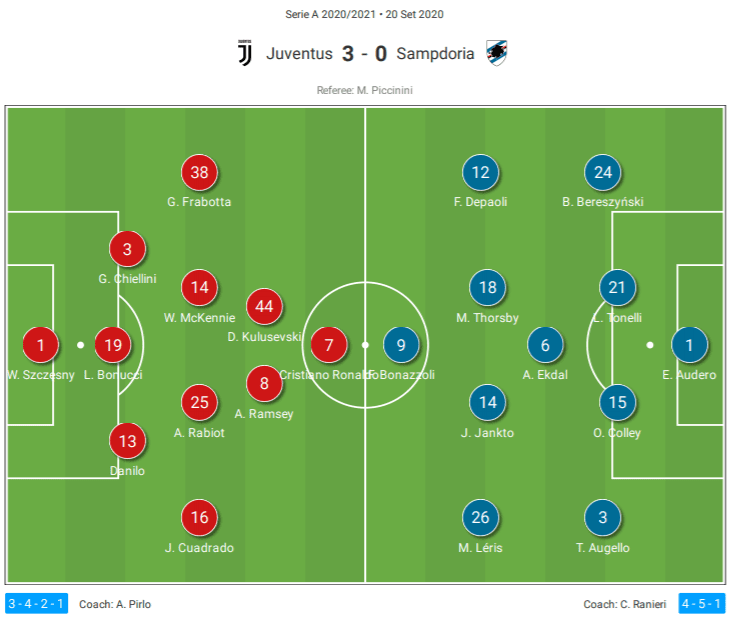
Trends in Pirlo’s Juventus
Juventus retained most of the ball possession, recording a dominant 65 percent. While keeping the ball, Pirlo’s men displayed several different ideas from those of last season under the management of Sarri.
In his recent dissertation for the UEFA Pro license, a document that was publicly released by Italian football governmental body “FIGC,” Pirlo explained how he wants his team to position in a 3-2-5 or 2-3-5 while in possession. From the early stages of the match, Juventus kept two players wide, one on each wing, with the job of occupying the entire width of the field. In this match, this task was usually taken up by Frabotta and Cuadrado, as visible in the image below.
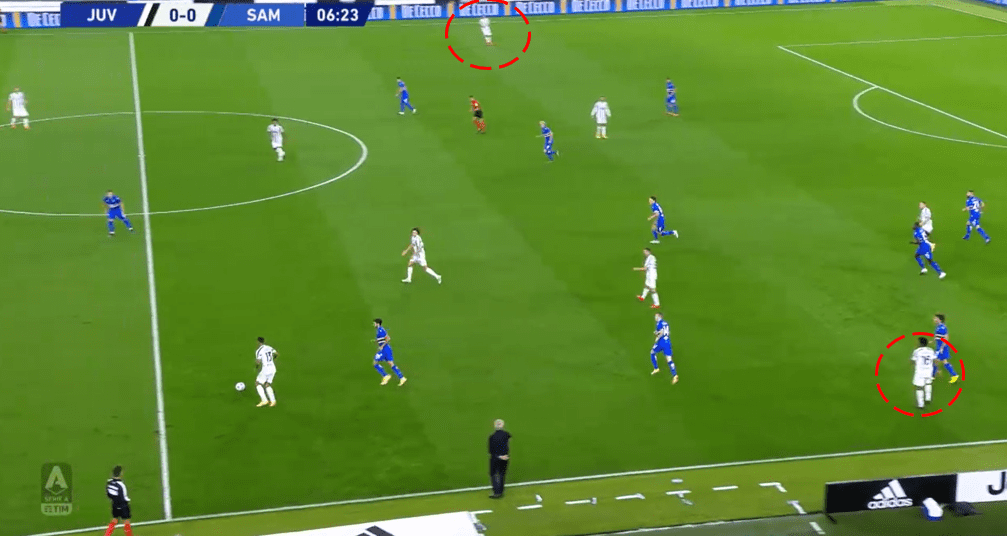
The line of five on top for Juventus, made of the two wingers and the three players in the so-called “rifinitura,” or “finishing area,” are visible below.
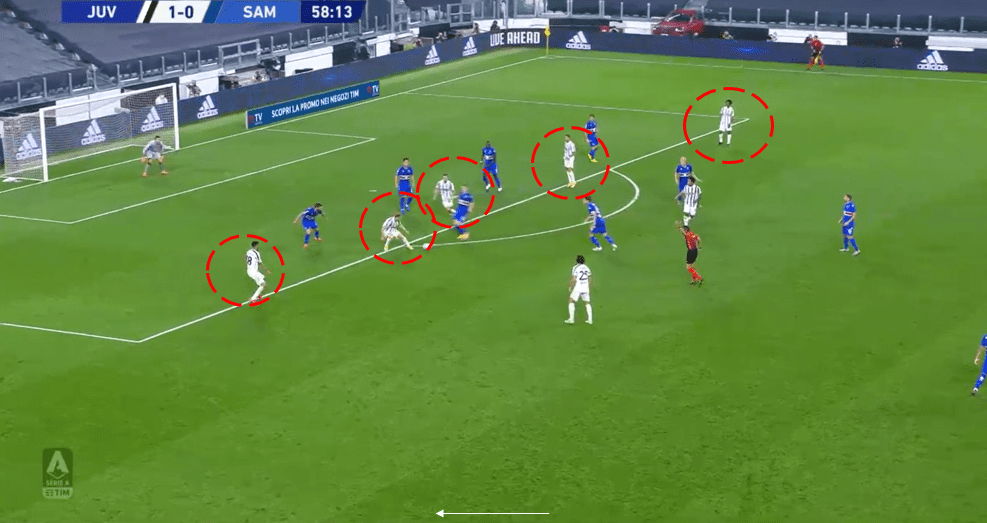
Keeping the wingers very wide allowed Juventus to quickly switch their play from one side to another, thus shifting the opponent’s defensive lines. Thanks to his abilities to deliver accurate long passes, Bonucci was often the player taking up the duty of switching the side of attack for the bianconeri. The picture below shows Bonucci finding Mattia De Sciglio wide open on the left side after Juventus have been moving the ball on the right. Notice how, as the ball is travelling, the blue jerseys are caught unprepared and now have to sprint to shift over and try closing down a wide-open De Sciglio.
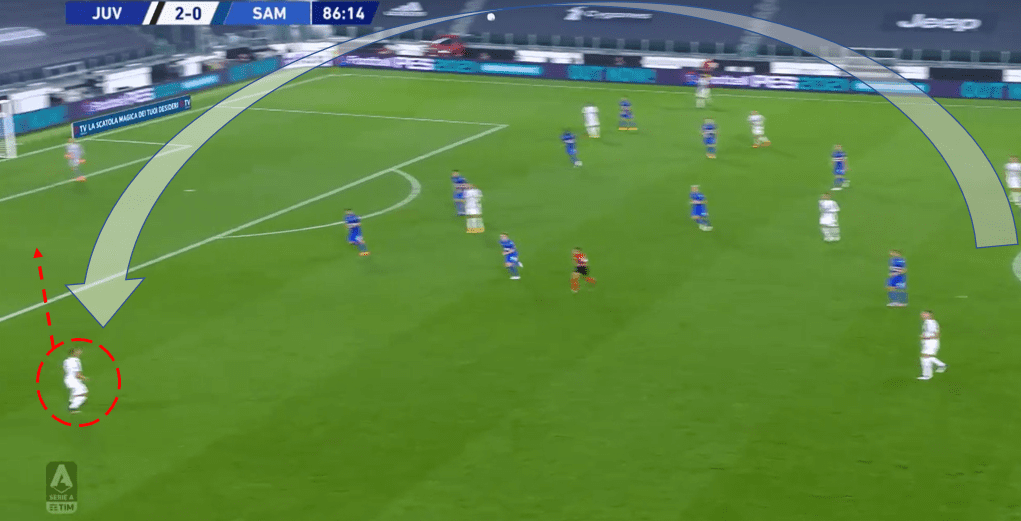
The front two players in Juventus’s 3-5-2, Ronaldo and Kulusevski, were joined by one of the three central midfielders when Juventus were attacking. This player was usually Ramsay thanks to his tendency to make runs forward. Having three men next to each other in that part of the field is another concept of Pirlo’s coaching theory. In this “rifinitura” zone, Pirlo wants his most talented players to stay close to each other and unleash their creativity with combinations to goal. The pictures below show examples of Ronaldo, Kulusevski and Ramsey besides one another in that space.

This formation causes many bianconeri players to be found in the opponent’s half. This is why when Juventus lose possession, Pirlo wants his men to “defend while running forward.” In other words, his men are asked to apply quick pressure upon giving away the ball to force the opponent to make a mistake. If the ball is not won back in a timely fashion (Pirlo wrote about a five-second rule in his dissertation), the team drops and reorganizes its defensive structure.
Sampdoria’s approach
In the first half, Sampdoria aimed to condense the space for Juventus’ front players by sitting on top of their box with nine of their 10 outfield players. These were often seen very close to one another, with only centre-forward Bonazzoli keeping a high position up the pitch.
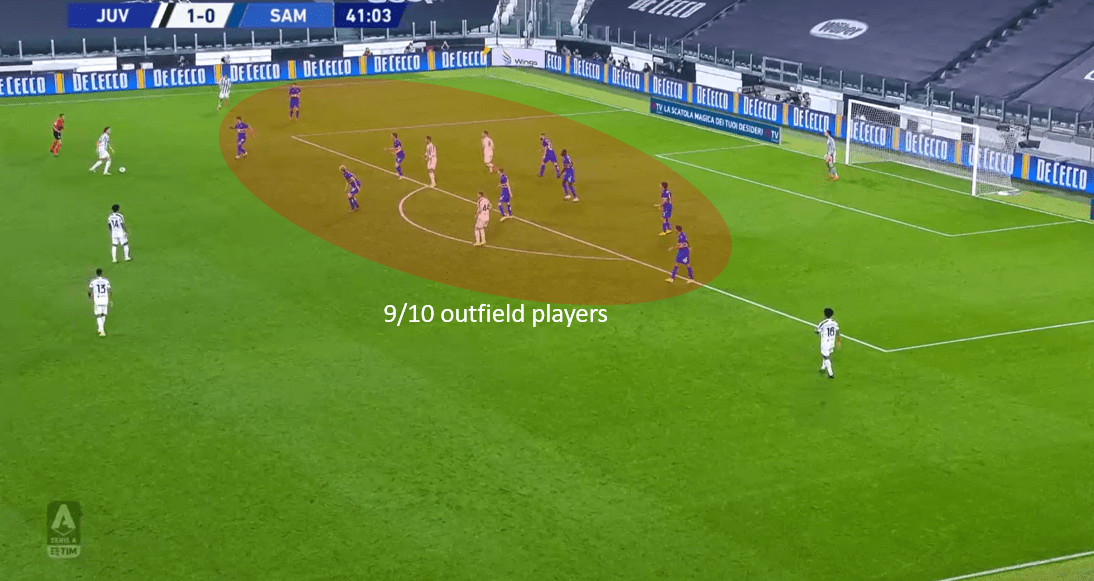
Despite going down 1-0 in the 13th minute, keeping a compact block was key for Sampdoria to stay in the game as long as possible. In their 4-5-1 formation, which is well visible in the images below, great effort was especially required by wingers Depaoli and Leris to track back Juventus’s wing-backs, Frabotta and Cuadrado, respectively.

This cautious approach by the blucerchiati left centre-forward Bonazzoli dealing with two Juventus’s centre-backs, usually Bonucci and Chiellini. The picture below is a good summary of how deep Bonazzoli had to operate in the first half. Because his teammates were dropping back into their own half, Bonazzoli often looked isolated and too far from Juventus’s goal to be dangerous.
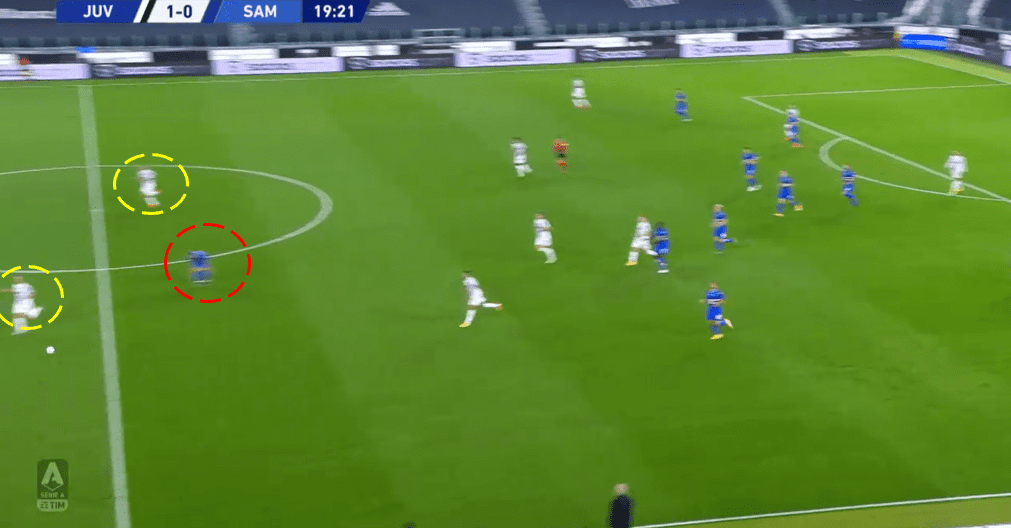
Offensively, Sampdoria tried to create numerical superiority on the flanks with their wingers and full-backs. The objective was to exploit those areas where Juventus had only one man and, from those spaces, deliver dangerous crosses or penetrate.
The Sampdoria players, however, lacked cleanliness on the ball when executing their offensive plays. The quality of their shots was, in fact, very low throughout the entire match. Out of 14 total shots, only one was on target. (It was a header by Augello that forced Szczęsny to make a great save.)
A more aggressive Sampdoria in the second half
Going into halftime, Sampdoria was still in the game, and Ranieri’s changes suggested he wanted his side to be more aggressive. He subbed off both his wingers, Depaoli and Leris, and reshaped the line-up into their typical 4-4-2. The introduction of Gaston Ramirez and Quagliarella in the second half added unpredictability to an attack that, despite having been much involved in their side’s defensive contribution, had been too sterile going forward.
The blucerchiati were able to bring bigger numbers into Juventus’ box in the second half. This resulted in more opportunities being created, as visible in the difference in expected goals between the first and second 45 minutes of the match. In the first half, Sampdoria had a low 0.25 xG, while they were able to bring this figure up to 1.24 in the second half.
This more aggressive tendency, however, came at a cost. Sampdoria were more exposed to Juventus’s offensive quality and had to deal with situations in which their defenders were outnumbered against Juventus’ pacey players. The picture below shows Ramsey with a clear opportunity to engage the Sampdoria defensive line in a three-versus-two situation.
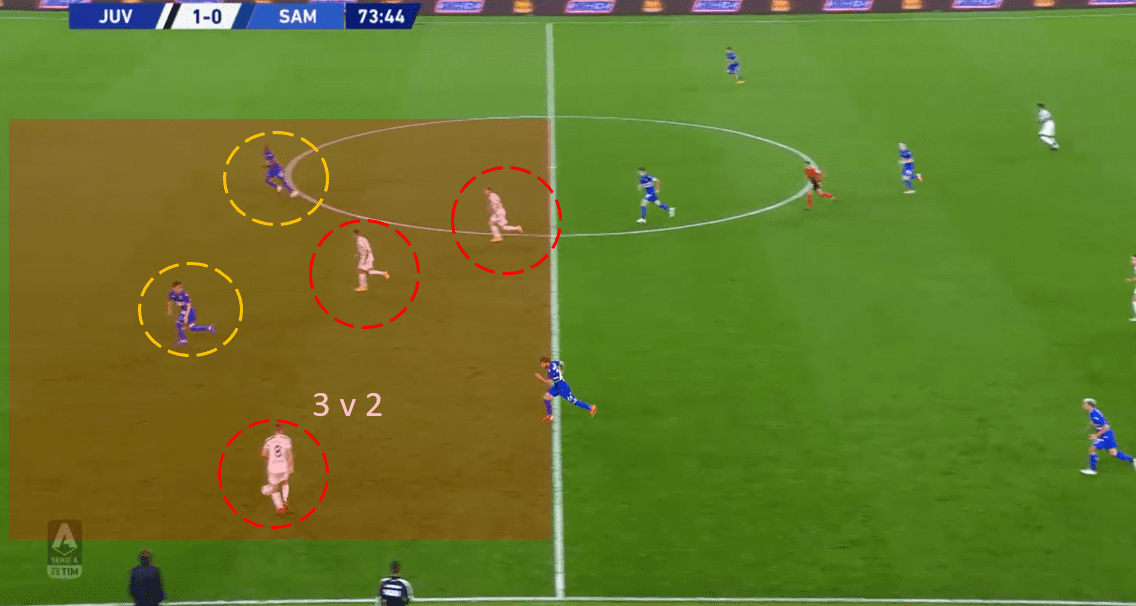
The Ronaldo factor
Ronaldo was the most active player on the pitch offensively. He took nine shots, three of which were on goal. It is a figure even higher than last year’s average, when he led Serie A in shots per 90 minutes with 5.79.
His shots were not only consistent but also dangerous. On one of them, he hit the crossbar, while he forced goalkeeper Audero to make big saves on two other occasions. However, it was his continuous desire to attack the space behind Sampdoria’s defensive line that eventually earned him a goal in the 88th minute.
Throughout the entire game, Ronaldo would initiate his movement to attack the space when one of his teammates was facing forward with the ball at his feet. On the occasion of the goal, Ramsey had his head up and could therefore pick out Ronaldo with a through ball.
As we can see in the image below, Ronaldo’s body position invites the ball to be played into the space in front of him and behind Colley’s back. From there, Ronaldo then buries his chance with a shot across his body for the definitive 3-0
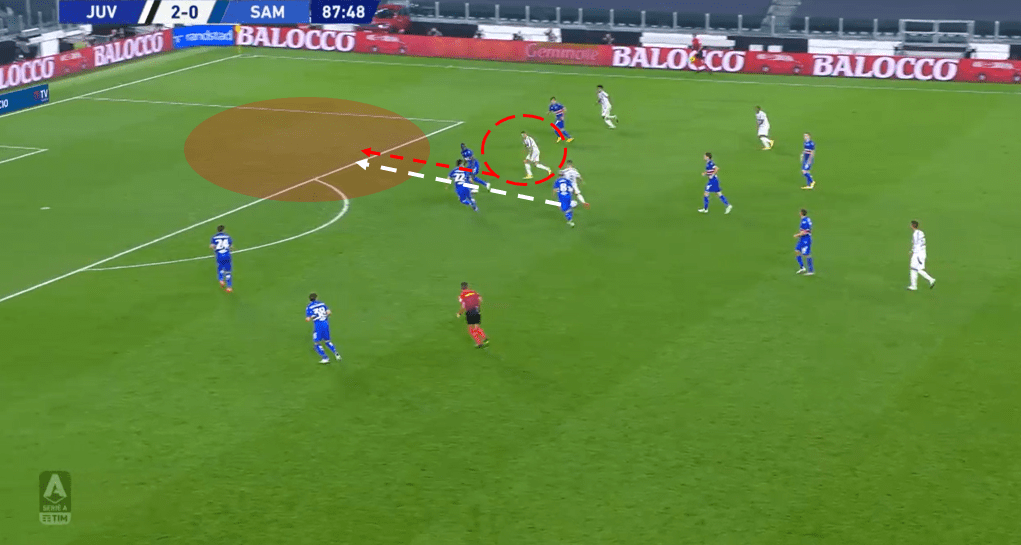
Conclusion
Despite not being able to count on several starters like Dybala, De Ligt and Sandro, Juventus pulled off a convincing win against a Sampdoria side that put in a great defensive effort and stayed in the game until the last 10 minutes. Pirlo’s men were mobile, moved the ball quickly and showed good chemistry from the early stages of the game. Ranieri’s side stayed compact while out of possession but lacked offensive sharpness to bring real threats to Szczęsny’s goal: while Juventus had eight shots on target, Sampdoria had only one the whole match.
The new look of the bianconeri, with their 3-5-2 or 3-4-1-2, has the potential to bring exciting football to this Serie A campaign. Pirlo has also shown to not be afraid of giving responsibilities to young players, as shown by the fact that he started McKennie, Frabotta and Kulusevski. Next week, Juventus will face Roma away in what will be an early tough test for the bianconeri. Ranieri will probably go back to his trademarked 4-4-2 for Sampdoria’s next home match against newly-promoted side Benevento. As Gabbiadini keeps recovering from his inguinal injury (he should be back around mid-October), it will be a five-man battle for two spots up front between Bonazzoli, Quagliarella, Ramirez, Valerio Verre and the youngster Mikkel Damsgaard.





Comments